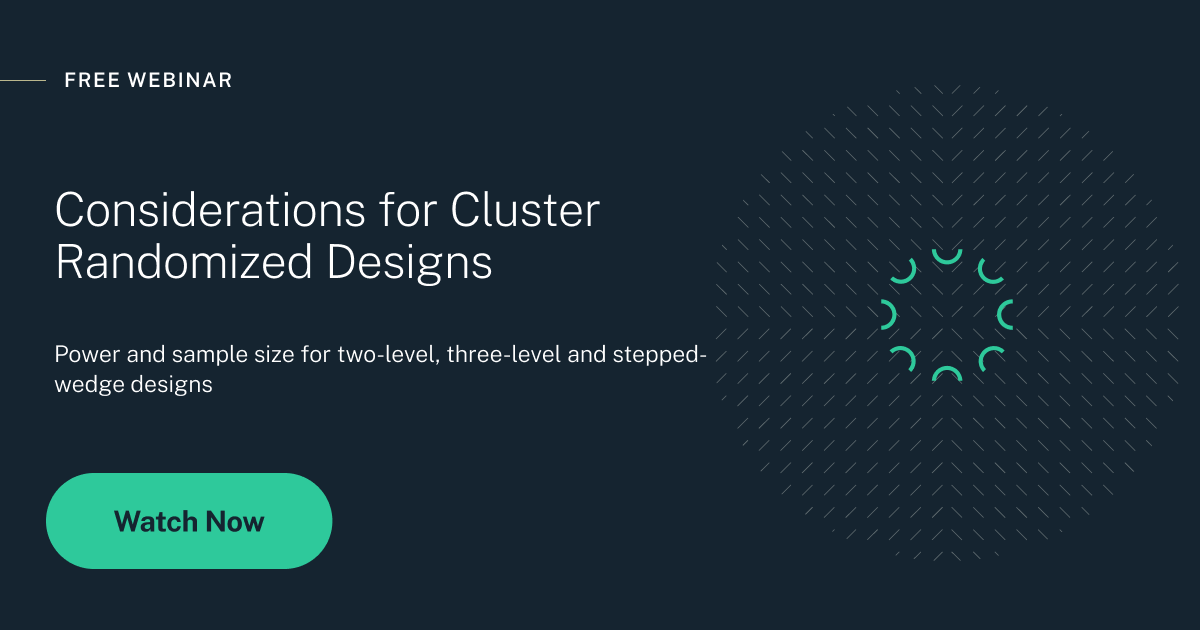Considerations for Cluster Randomized Designs
- 2 Level Means CRT Extension.nqt
- 2 Level Means CRT.nqt
- 2 Level Means Subject Randomization.nqt
- 2 Level CRT Rates Vaccine Trial.nqt
- 3 Level CRT Means 2nd Level Randomization.nqt
- 3 Level CRT Means.nqt
- Matched Pair CRT Proportions.nqt
- Stepped Wedge CRT Proportions.nqt
Webinar Playback:
Power and sample size for two-level, three-level and stepped-wedge designs
Individual randomization is the standard approach to randomization in clinical trials. However, logistical and practical challenges mean that other randomization schemes may be preferred. Cluster randomization, where all subjects in a cluster, such as a hospital or school, are randomly assigned to one group, is a common method which can help reduce costs and prevent bias but adds analysis complexity and reduces power vs individual randomization.
In this tutorial, we have covered the differences between individual and cluster randomization, the advantages and disadvantages of cluster randomization and how to find the appropriate sample size for various types of cluster randomization schemes.
Learning objectives:
In this tutorial, you will learn how to navigate the complexities of cluster randomized designs, empowering you to implement methodologically sound and efficient studies.
Key Areas Covered:
1. Understanding Cluster Randomized Designs
-
Recognize the practical advantages of cluster randomization (e.g., reduced contamination, logistical feasibility, administrative convenience).
-
Identify the key statistical challenges, including reduced power and the need to account for within-cluster correlation (Intracluster Correlation Coefficient - ICC).
2. The Impact on Power and Sample Size
- Learn how the ICC and cluster size influence the design effect and drastically impact the required sample size.
-
Understand the difference between powering a trial based on the number of clusters versus the number of subjects.
3. Designing Different Cluster Randomization Schemes
- Apply principles to design:
- Two-level designs (subjects within clusters).
- Three-level designs (e.g., subjects within classrooms within schools).
- Stepped-wedge designs where clusters cross over from control to intervention over time.
- Interpret how the choice of design affects the trial's timeline, power, and analytical model.
4. Practical and Analytical Considerations
- Address the logistical challenges of implementing cluster randomization (e.g., recruitment variation across clusters, ethical considerations).
- Understand the basic analytical approaches required for correlated data from cluster designs.
5. Tools and Best Practices
-
Discover how nQuery streamlines sample size calculation for various cluster randomized trials.
-
Compare the implications of different design choices to optimize feasibility and robustness.
Considerations for Cluster Randomized Designs
Power and sample size for two-level, three-level and stepped-wedge designs
Individual randomization is the standard approach in clinical trials. Subjects are assigned randomly to treatment groups regardless of their location or characteristics. However, logistical and practical challenges often mean that other approaches are needed.
Cluster randomization, where all subjects in a cluster such as a hospital or school are assigned to the same group, is a widely used alternative. This method can reduce costs and prevent bias due to contamination but introduces additional complexity in design, analysis, and interpretation. Importantly, cluster randomization typically reduces statistical power compared with individual randomization.
This guide outlines the key differences between individual and cluster randomization, the advantages and disadvantages of cluster randomization, and how to determine the appropriate sample size for different cluster randomized designs.
Understanding the Limitations of Cluster Randomization
Although cluster randomization solves several practical issues, it is not without drawbacks. Reduced statistical power and more complex analyses are common challenges. Researchers must also consider how clustering affects interpretation and whether larger sample sizes are required to compensate for intra-cluster correlation.
Careful planning is needed to ensure trials remain robust and efficient when adopting this design.
Types of Cluster Randomization
Cluster randomization can take several forms, each with distinct implications for study design and analysis:
-
Two-Level Randomization – Subjects are clustered within institutions (e.g., hospitals), with all subjects in a given cluster receiving the same treatment.
-
Three-Level Randomization – More complex clustering structures such as classrooms within schools, or repeated measurements per subject, where multiple levels influence power and analysis.
-
Stepped-Wedge and Matched-Pair Designs – Variations that aim to improve efficiency or coverage compared with standard cluster randomization.
The choice of design depends on the research question, practical constraints, and desired efficiency.
Power and Sample Size Planning
Cluster randomized trials require careful consideration of sample size because individuals within a cluster are correlated. This correlation reduces the effective sample size, meaning that more subjects may be needed to achieve the same level of power as an individually randomized trial.
Two-level, three-level, and stepped-wedge designs each present unique challenges for sample size determination. Addressing these appropriately ensures that trials are neither underpowered nor wastefully overpowered.
Best Practices for Biostatisticians
To design effective cluster randomized trials, biostatisticians should:
-
Understand the differences between individual and cluster randomization.
-
Weigh the pros and cons of adopting a cluster randomized approach.
-
Select the most suitable design type (two-level, three-level, stepped-wedge, or matched-pair).
-
Incorporate clustering effects into power and sample size calculations.
nQuery helps make your clinical trials faster, less costly and more successful. So if you need something more than just a sample size calculator, nQuery is an end-to-end platform covering Frequentist, Bayesian, and Adaptive designs with 1000+ sample size procedures.
nQuery Solutions
Sample Size & Power Calculations
Calculate for a Variety of frequentist and Bayesian Design
Who is this for?
This will be highly beneficial if you're a biostatistician, scientist, or clinical trial professional that is involved in sample size calculation and the optimization of clinical trials within:
- Pharma and Biotech
- CROs
- Med Device
- Research Institutes
- Regulatory Bodies














